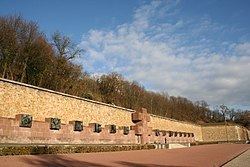 | ||
Similar Mémorial de la France co, Gare de Suresnes‑Mont‑Valérien, Suresnes American Cemetery, Musée d'histoire urbaine e, Nanterre Cathedral | ||
Fort Mont-Valérien (Fort du mont Valérien or simply Mont-Valérien) is a fortress in Suresnes, a western Paris suburb, built in 1841 as part of the city's ring of modern fortifications. It overlooks the Bois de Boulogne.
Contents
- Map of Fort Mont ValC3A9rien 92150 Suresnes France
- History
- Notable people executed by the Germans at Mont Valrien
- Fort Mont Valrien as a Memorial
- References
Map of Fort Mont-Val%C3%A9rien, 92150 Suresnes, France
History
The fortress defended Paris during the Franco-Prussian War, and remained the strongest fortress protecting the city, withstanding artillery bombardments that lasted several months. The surrender of the fortress was one of the main clauses of the armistice signed by the Government of National Defense with Otto von Bismarck on 17 January 1871, allowing the Germans to occupy the strongest part of Paris' defences in exchange for shipments of food into the starving city.
Colonel Henry of army intelligence, a key player in the Dreyfus Affair, was confined at the prison of Mont-Valérien in 1898. The day after being confined, 31 August 1898, he cut his throat with a razor that had been left in his possession, taking to the grave his secret and that of a great part of the affaire Dreyfus. (See Resolution of the Dreyfus Affair.)
During the Second World War, the fortress was used, from 1940 to 1944, as a prison and place of executions by the Nazi occupiers of Paris. The Germans brought prisoners here in trucks from other locations. The prisoners were temporarily confined in a disused chapel, and later taken to be shot in a clearing 100 metres away. The bodies were then buried in various cemeteries in the Paris area. More than 1,000 hostages and resistants were executed.
Notable people executed by the Germans at Mont-Valérien
The 1,014 recorded executions by the Wehrmacht at Mont-Valérien between 1941 and 1944 were all men as a French law, observed by the Germans, prohibited execution of women by firing squad. (Olga Bancic, condemned to death as a member of the Affiche Rouge group, was then deported to Stuttgart where she was beheaded by axe.) The immense majority were members of the French Resistance, including:
Fort Mont-Valérien as a Memorial
The site now serves as a national memorial. On 18 June 1945, Charles de Gaulle consecrated the site in a public ceremony.
Today, the area in front of the "Mémorial de la France combattante", a reminder of the French Resistance against the German occupation forces, has been named Square Abbé Franz Stock. During the German occupation, Stock took care of condemned prisoners here, and he mentioned 863 executions at Mont-Valérien in his diary.
There is also an American military cemetery on the site, the resting place of 1,541 American soldiers who died in France during the First World War.
